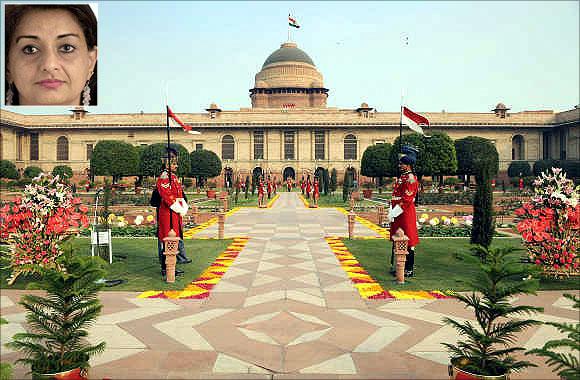Photographs: Pool/Reuters Faisal Kidwai in Mumbai
With more than 350 million people still living in extreme poverty in India, growth of anything less than eight per cent could seriously impact poverty, jobs and social cohesion, says Kalpana Kochhar, World Bank's Chief Economist for South Asia.
Kochhar, who has more than 20 years' experience from India to New Zealand and has held various positions at the International Monetary Fund, says one of the most important tasks for the government is to reduce fiscal deficit.
India is fortunate to be facing a very favourable demographic picture for the next 30-40 years, she tells Faisal Kidwai in an email interview.
Here are the excerpts.
Some economists are saying that fears over India's slow growth are overblown and that even six per cent growth rate is good. What is your view?
Work done by the IMF and by various commentators on India suggest that potential growth in India is around eight to 8.5 per cent.
Potential output refers to the level of output that is consistent with efficient use of a country's resources and can be sustained over a long period of time without generating inflation or other symptoms of disequilibrium.
Furthermore, there is by now convincing evidence that growth that is closer to this potential leads to (i) more rapid job creation; and (ii) more rapid poverty reduction.
With more than 350 million people still living in extreme poverty in India (on less than $1.25 per day), and an estimated 800,000 people entering the labour force every month, growth of anything less than eight to 8 1/2 per cent is not sufficiently ambitious and could seriously impact poverty, jobs and social cohesion in India.
...
Less than 8% growth will hurt India badly: Economist
Image: Shoppers exit a retail store inside a shopping mall in Mumbai.Photographs: Danish Siddiqui/Reuters
Looking at the macro picture, what do you think are the main economic challenges facing the country?
For a long time, it has been known that India is a chronically supply constrained economy. But these supply constraints have become more acute in the past decade or so, even at the same time that the economy has been growing.
This is because the growth in demand and incomes is outstripping the growth in supply - of nearly everything, energy, food, roads, ports, airports, clean water, sanitation services, etc.
These supply constraints are manifested in high and persistent inflation and in current account deficits. India is fortunate to be facing a very favourable demographic picture for the next 30-40 years.
Specifically, the share of working age population is rising and the share of young and old dependents is small. These demographic trends can provide the resources for the investments needed to meet the employment and growth challenge if there is a conducive policy environment.
India has reaped the benefits of the first and significant wave of liberalisation and reforms implemented in the early 1990s. A second generation of reforms is urgently needed to address the supply constraints to continue to keep the economy along this high growth trajectory.
An important starting point is for the government to reduce its claim on the economy's financial resources by cutting the fiscal deficit from the current levels of deficits of nearly 10 per cent of GDP (for the general government) so that more resources are freed up for productive investments in both the public and private sectors.
...
Less than 8% growth will hurt India badly: Economist
Image: A woman walks by a Louis Vuitton luxury boutique at the IFC Mall in Shanghai.Photographs: Carlos Barria/Reuters
You have been with World Bank and IMF for more than 20 years and have worked in many countries, including China. So, where do you think the global economy is headed?
I would suggest you consult the latest IMF World Economic Outlook for a more comprehensive answer to this one. But the main point for India is that there is going to be little support for the Indian economy from external demand as there was in the 2003-2007 period.
The imperative to speed up reforms is therefore all the more important so that India can resume on the growth trajectory needed to create jobs and reduce poverty.
...
Less than 8% growth will hurt India badly: Economist
Image: A boy poses at a laterite brick mine in Ratnagiri district, 360km south of Mumbai.Photographs: Danish Siddiqui/Reuters
You have connected malnutrition to economic development. Why do you think it's important to focus on women and child health?
First some statistics. About 44 per cent of children in India suffer from wasting defined as low weight for age, and nearly 50 percent of children suffer from stunting defined as low height for age.
We know that the human growth process and cognitive skills are highly dependent on nutrients received in the first 1000 days of life - from conception to two years of age. There is a strong link between malnutrition and reduced cognitive capacity.
There is also some evidence that deficiencies in early childhood development and cognitive capacity affect productivity and earnings in adult life. Based on these links, at the current levels of malnutrition, individual productivity losses are estimated to be more than 10 per cent of their lifetime earnings, and GDP lost to malnutrition could be as high as two-three per cent. Gender matters for nutrition indicators.
Looking at the percentage of children age six months who are two standard deviations below expected weight for age, the percentage is roughly equal at around 32 per cent for boys and girls. By age five, the gap widens significantly between boys (44 per cent) and girls (49 per cent). With the high rate of adolescent girls having children, we are perpetuating a lifecycle of malnutrition.
A large percentage of new mothers are still children themselves, a staggering 75 per cent of them are anemic, and some one third of all babies in India are born with low birth weights.
We also know that while not genetic, malnutrition is inter-generational, meaning that it takes a few generations for the once malnourished girl to become the grandmother of a well-nourished child.





article